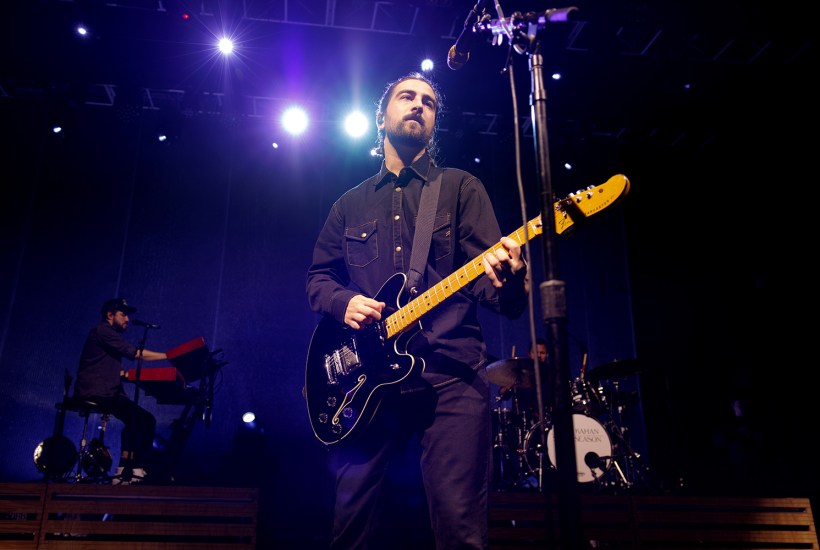I first heard of Noah Kahan in a cave in France this summer, when my 23-year-old daughter started wailing with distress at realising she had missed the chance to buy tickets to see him because she was in a cave when they went on sale (two shows at the Forum sold out in seconds). Kahan, a 26-year-old singer-songwriter from Vermont, has so far made very little impact on the world of the over-thirties, but his contemporaries and those a little younger adore him. If you Google reviews, you won’t find very much from the traditional music press or from big newspapers and magazines – but you’ll find plenty from student papers.
What they like so much about him is a little mysterious. He plays in a style identified by one Twitter wag as ‘stomp clap hey’: a little bit folky, a little bit raucous. Mumford & Sons and the Lumineers were the pioneers of ‘stomp clap hey’. It involves a lot of stomping, clapping and shouting ‘hey’.
As my daughter put it: he’s got sad songs and he’s got sadder songs
Kahan had a four-piece band on stage to add a bit of muscle (there were guitar solos, accompanied by gurning, for those doubting his rock chops). He was a witty stage presence: ‘I’ve been given this amazing platform,’ he noted early in the show, ‘and it would be wrong not to use it to make you feel shittier about yourselves.’ But that wit doesn’t get employed in his lyrics, which tend to be about some combination of prescription drugs, heartbreak, self-loathing and living in Vermont. As my daughter put it: he’s got sad songs, and he’s got sadder songs.
It’s all very #relatable: Kahan’s songs – each of them echoed back to him by an uncomfortably crowded room – portrayed life as a series of low-key melodramas, which is certainly how I thought of my life in my early twenties. They have that sense of feeling left behind that has only been intensified by the social media age. ‘I’ll drink alcohol till my friends come home for Christmas/ And I’ll dream each night of some version of you’, from the song ‘Stick Season’, is a pretty reasonable description of the life of the unemployed new graduate. And there are enough of them around that he’s back in London for two arena shows in February.
The godfather of #relatable folk-adjacent music, of course, is Ed Sheeran, who swapped stadiums for a couple of nights slumming it at the Albert Hall. He was playing his whole new album with – for the first time – a full band. That album, Autumn Variations, was his under-the-radar personal one, not one of his maths-symbol-titled blockbusters, and it reflected the latest trend among pop royalty. Where, 50 years ago, they would head into the country and try to sound like the Band, now they bring in the National’s Aaron Dessner to produce and co-write and come up with something that’s, like, dead arty and profound, a path pioneered by Taylor Swift on her albums Folklore and Evermore. Swift’s Dessner collabs were masterpieces. Sheeran’s are not. Hence the crowd suddenly coming to life in the second half for the greatest hits, which he played solo. During Autumn Variations, he promised to explain what the songs were about, and demonstrated his explication skills with his introduction to the song ‘England’: ‘This was written in Kent, on the coast.’
It was very tasteful, perfectly pleasant, and Sheeran was plainly awfully happy: he kept making pointed comments about how nice it was to play to an audience that was sitting down and listening to his songs, rather than shouting along. But these were songs devoid of anything memorable: only ‘American Town’ had the kind of hook that really sinks in. But, alas, it has always been the way that megastars must prove their seriousness by making something unexciting. The greatest hits were livelier. But there were problems here, too. Sheeran, as you may know, plays live by using a loop pedal. So he plays something, records it, then plays it back, while he creates something different on top.
The drawbacks with this are, first, that he has to spend a couple of minutes building the loops before he gets to the actual singing and, second, that because the loops are limited – four, eight, maybe 16 bars – each song’s foundation is actually very small. For many of them, the main loop was the key melodic figure or riff. That means the songs didn’t change: no key changes, no time changes, just the same melody, slightly mutating. A choice that initially would have given him more freedom when he had no money to pay a band (but didn’t want to just be a bloke with an acoustic guitar) is now a straitjacket.
Still, according to the Sunday Times, he’s worth £300 million. And I’m not. So who knows best?
Got something to add? Join the discussion and comment below.
Get 10 issues for just $10
Subscribe to The Spectator Australia today for the next 10 magazine issues, plus full online access, for just $10.
You might disagree with half of it, but you’ll enjoy reading all of it. Try your first month for free, then just $2 a week for the remainder of your first year.








Comments
Don't miss out
Join the conversation with other Spectator Australia readers. Subscribe to leave a comment.
SUBSCRIBEAlready a subscriber? Log in